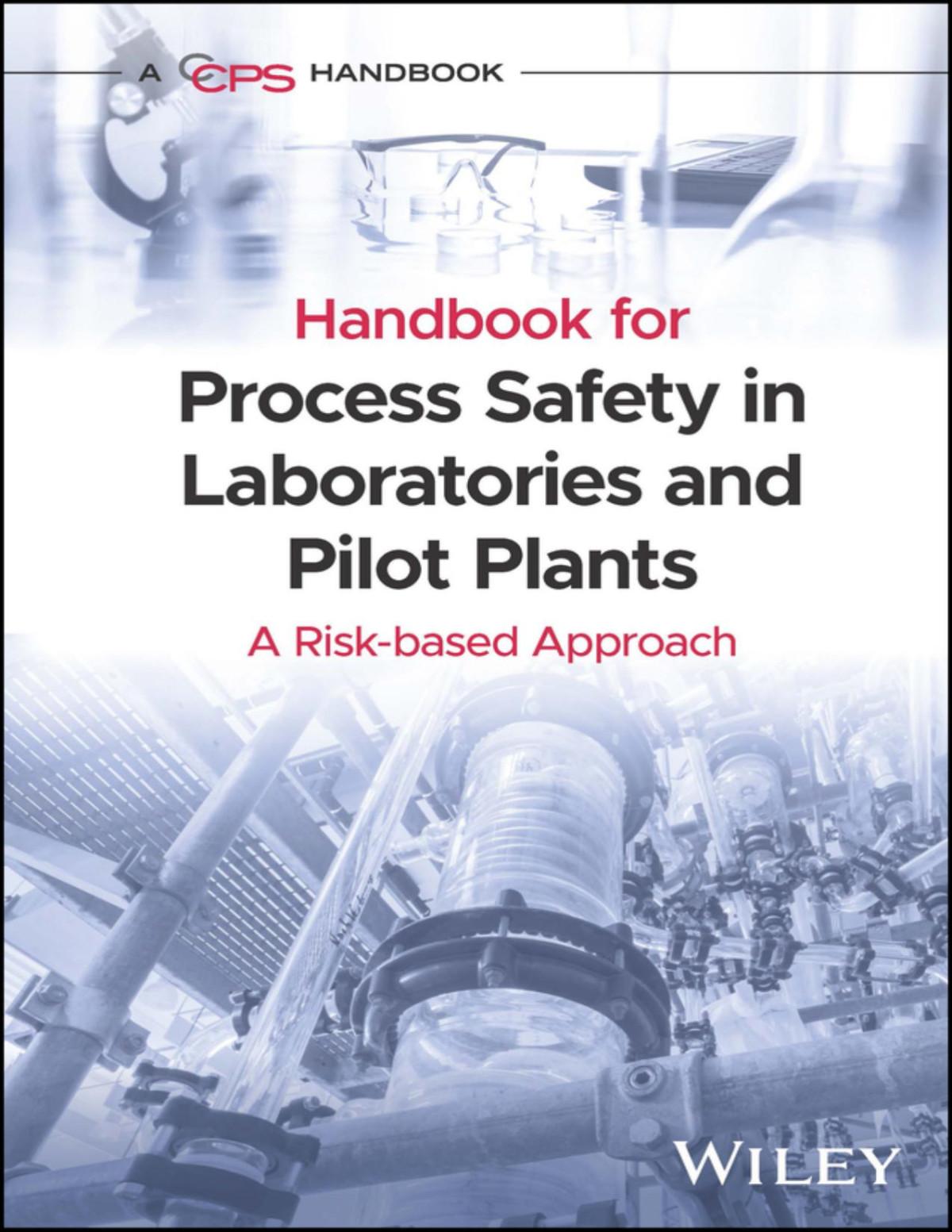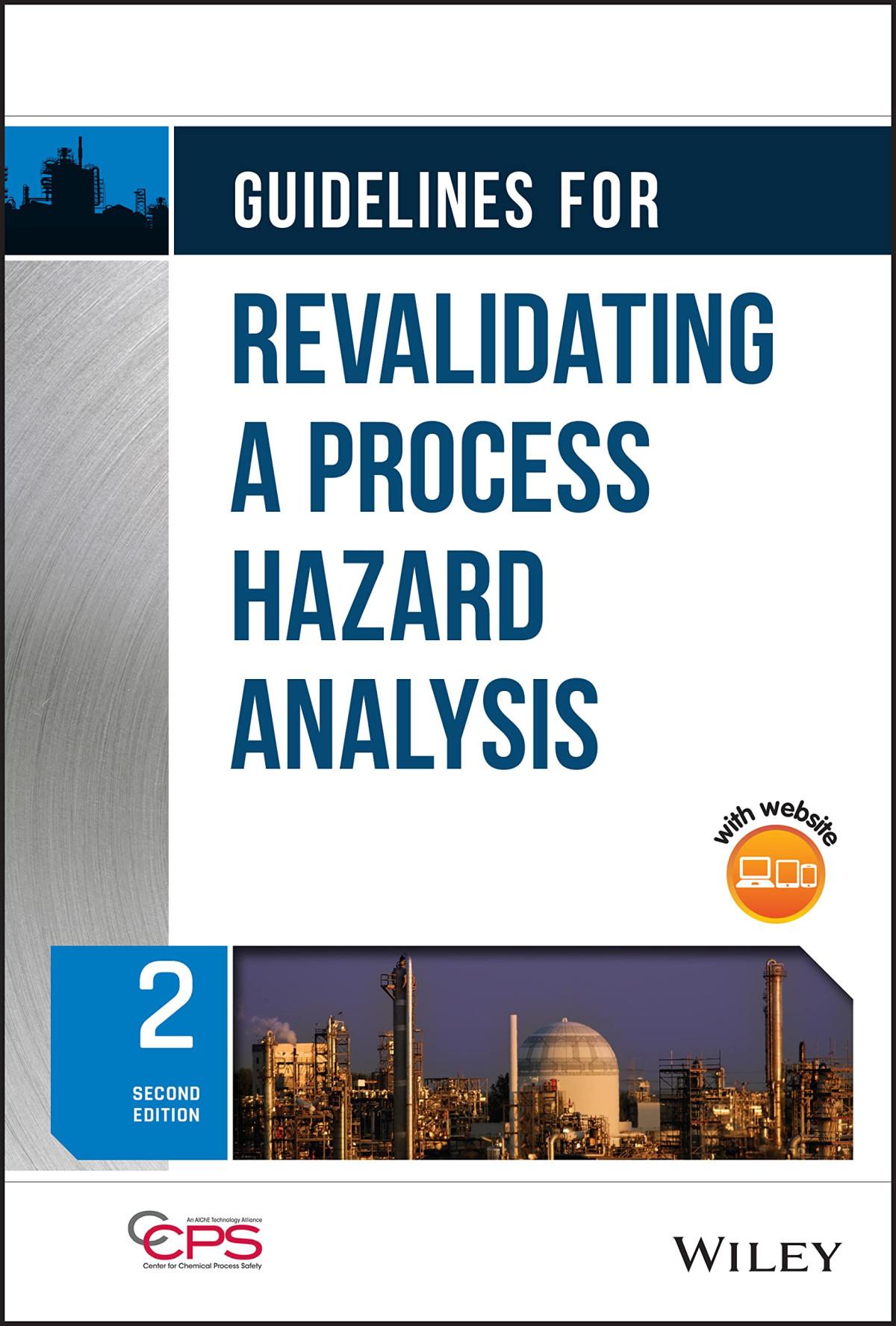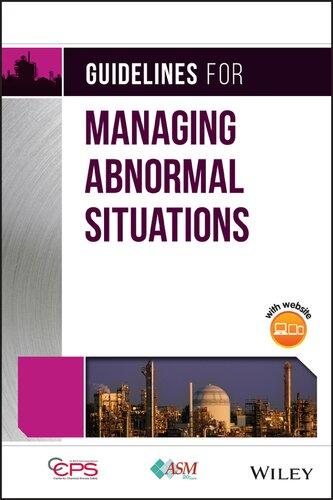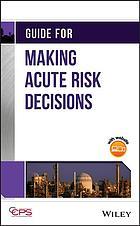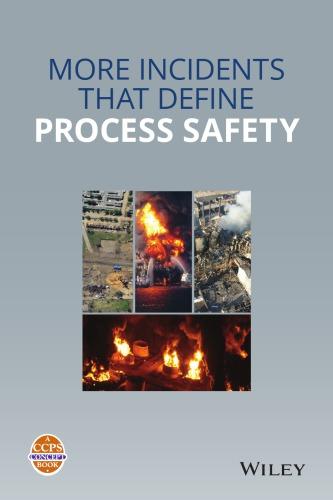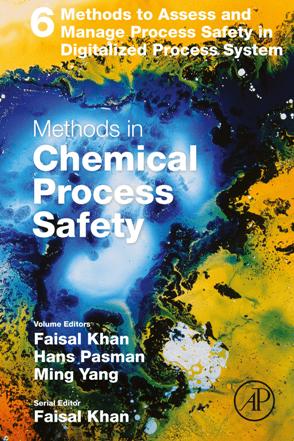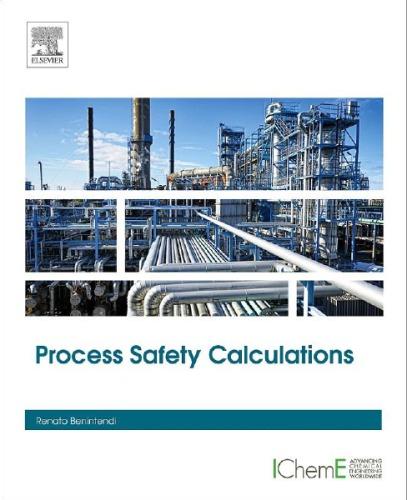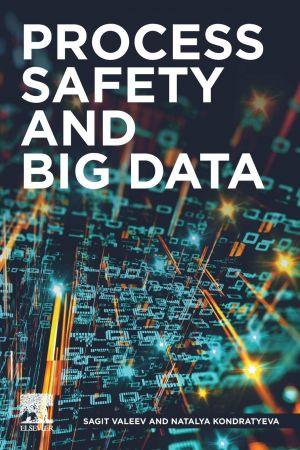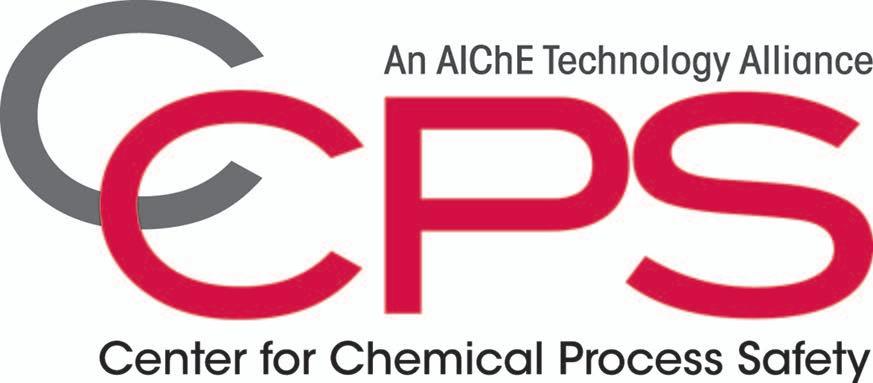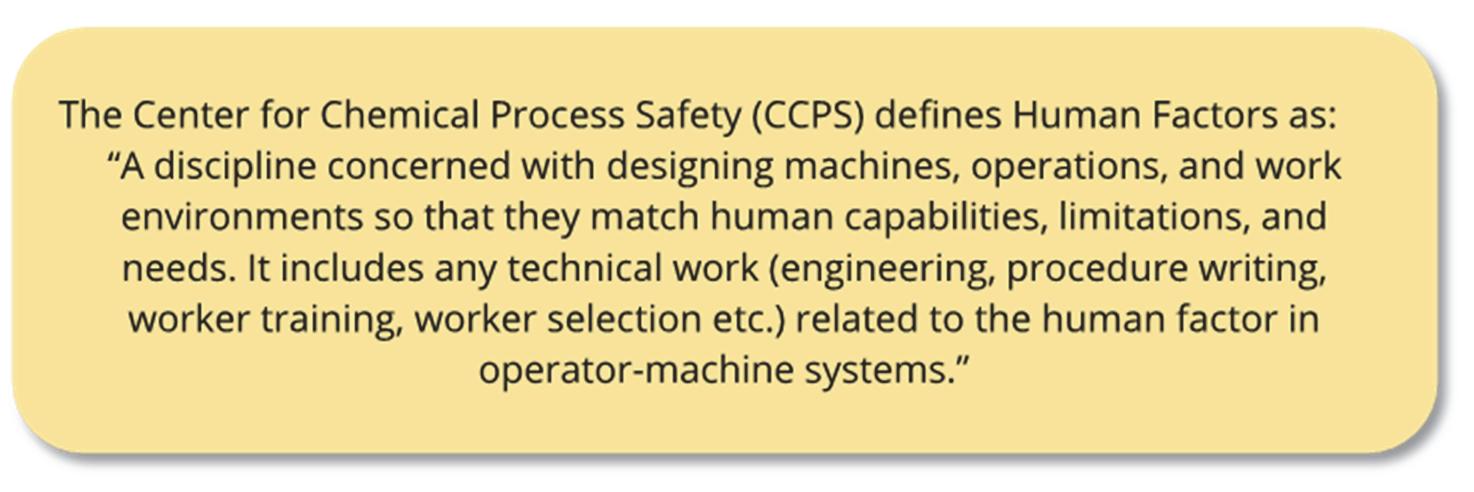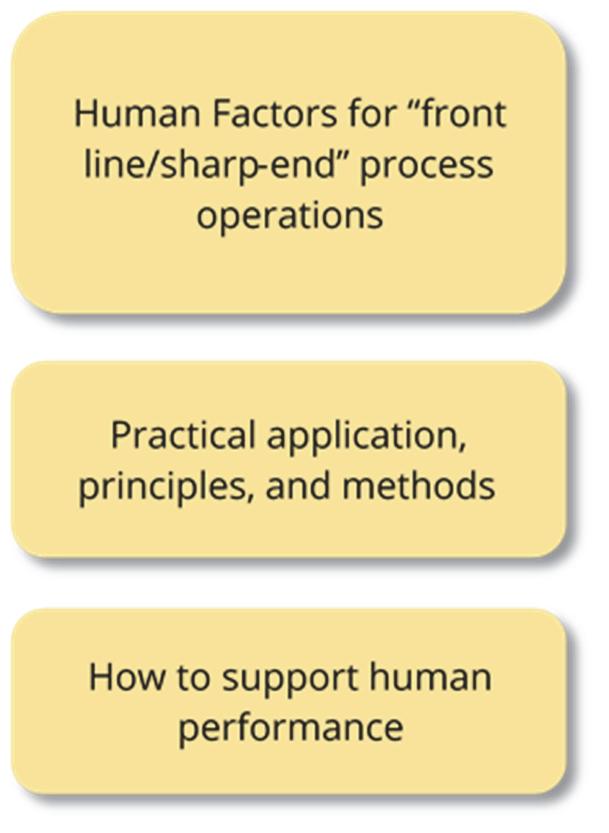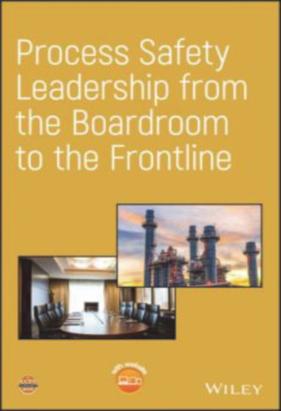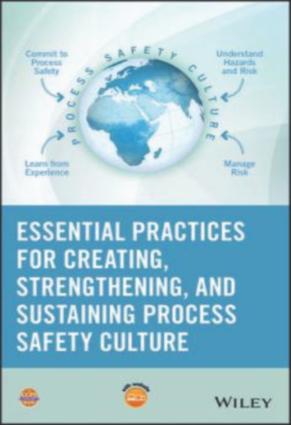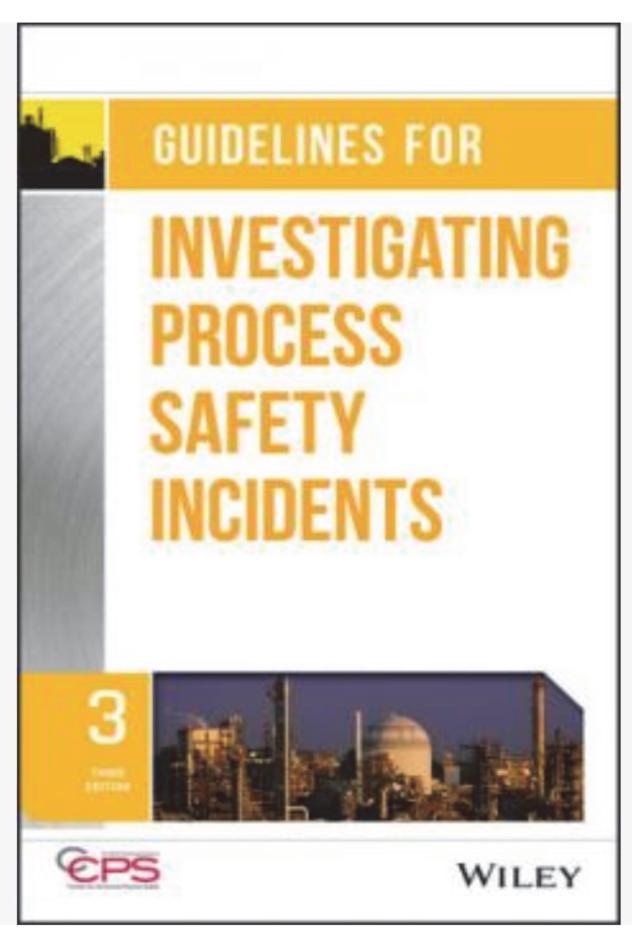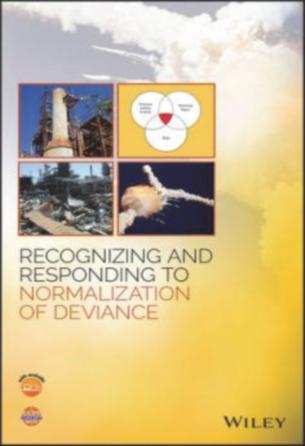HUMAN FACTORS HANDBOOK
FOR PROCESS PLANT OPERATIONS
Improving Process Safety and System Performance
CENTER FOR CHEMICAL PROCESS SAFETY
AMERICAN INSTITUTE OF CHEMICAL ENGINEERS
New York, NY
This edition first published 2022 © 2022 the American Institute of Chemical Engineers
A Joint Publication of the American Institute of Chemical Engineers and John Wiley & Sons, Inc.
All rights reserved. No part of this publication may be reproduced, stored in a retrieval system, or transmitted, in any form or by any means, electronic, mechanical, photocopying, recording or otherwise, except as permitted_by law. Advice on how to obtain permission to reuse material from this title is available at http://www.wiley.com/ go/permissions.
The rights of CCPS to be identified as the author of the editorial material in this work have been asserted in accordance with law.
Registered Office
John Wiley & Sons, Inc., 111 River Street, Hoboken, NJ 07030, USA
Editorial Office
111 River Street, Hoboken, NJ 07030, USA
For details of our global editorial offices, customer services, and more information about Wiley products visit us at www.wiley.com.
Wiley also publishes its books in a variety of electronic formats and by print-on-demand. Some content that appears in standard print versions of this book may not be available in other formats.
Limit of Liability/Disclaimer of Warranty
In view of ongoing research, equipment modifications, changes in governmental regulations, and the constant flow of information relating to the use of experimental reagents, equipment, and devices, the reader is urged to review and evaluate the information provided in the package insert or instructions for each chemical, piece of equipment, reagent, or device for, among other things, any changes in the instructions or indication of usage and for added warnings and precautions. While the publisher and authors have used their best efforts in preparing this work, they make no representations or warranties with respect to the accuracy or completeness of the contents of this work and specifically disclaim all warranties, including without limitation any implied warranties of merchantability or fitness for a particular purpose. No warranty may be created or extended by sales representatives, written sales materials or promotional statements for this work. The fact that an organization, website, or product is referred to in this work as a citation and/or potential source of further information does not mean that the publisher and authors endorse the information or services the organization, website, or product may provide or recommendations it may make. This work is sold with the understanding that the publisher is not engaged in rendering professional services. The advice and strategies contained herein may not be suitable for your situation. You should consult with a specialist where appropriate. Further, readers should be aware that websites listed in this work may have changed or disappeared between when this work was written and when it is read. Neither the publisher nor authors shall be liable for any loss of profit or any other commercial damages, including but not limited to special, incidental, consequential, or other damages.
Library
Cover Design: Wiley
Cover Image: Pand P Studio/Shutterstock, manine99/ Shutterstock, agsandrew/Shutterstock
This book is one in a series of process safety guidelines and concept books published by the Center for Chemical Process Safety (CCPS). Refer to www.wiley.com/go/ccps for full list of titles in this series.
It is sincerely hoped that the information presented in this document will lead a better safety record for the entire industry; however, neither the American Institute of Chemical Engineers, its consultants, CCPS Technical Steering Committee and Subcommittee members, their employers, their employers' officers and directors, nor Greenstreet Berman, Ltd., and its employees and subcontractors warrant or represent, expressly or by implication, the correctness or accuracy of the content of the information presented in this document. As between (1) American Institute of Chemical Engineers, its consultants, CCPS Technical Steering Committee and Subcommittee members, their employers, their employers' officers and directors, and Greenstreet Berman, Ltd., and its employees and subcontractors, and (2) the user of this document, the user accepts any legal liability or responsibility whatsoever for the consequence of its use or misuse. to
Human Factors Handbook for Process Plant Operations is dedicated to
Jack L. McCavit
Jack is passionate about process safety, especially in the areas of culture and human factors. His work, both in his career at Celanese, and after his retirement, has concentrated on educating workers and industry leaders on the importance of process safety, the payback of sustaining a great program, and most importantly, the impact of not making process safety a top priority. Jack had firsthand experience with the latter when he witnessed a butane vapor cloud explosion at the Celanese site in Pampa, Texas, in 1987, resulting in three fatalities and dozens of injuries. Based on his significant and relevant expertise, Jack was selected as the technical manager for the prominent Baker Panel investigation of the BP Texas City Explosion in 2005.
Jack is a CCPS Fellow, an AIChE Fellow, and is rumored to be the fifth most famous Texan in history. He was the committee chair for the CCPS flagship book, Guidelines for Risk Based Process Safety, and a driving force behind CCPS’s Vision 20/20.
It is both an honor and a privilege to see Jack in action!
Louisa A. Nara, CCPSC CCPS Global Technical Director
List of Figures
Figure
Figure
Figure
Figure
Figure
Figure
Figure
Figure
Figure
Figure
Figure
Figure
Figure
Figure
Figure
Figure
Figure
Figure
Figure
Figure
Figure
Figure
Table
Table
Table
Table
Table
Table
Table
Table
Table
Table
Table
Table
Table
Table
Table
Table
Table
Table
Table
Table
Table
Table
Table
Table
Table
Table
Table
Table
Table
Table
Table
Table
Table
Table
Table
Table
Table
Table
Table
Table
Table
Table
List of Tables
Table
Table
Table
Table
Table
Table
Table
Table
Table
Table
Table
Table
Table
Table
Table
Glossary
Accident: An event that can cause (or has caused) significant harm to workers, the environment, property, and the surrounding community.
Anthropometrics: The science of measuring the size and proportions of the human body (called anthropometry), especially as applied to the design of furniture and machines.
Behavioral marker: Non-technical behaviors that can be observed and described. They refer to a prescribed set of behaviors and are indicative of specific types of non-technical skills performance (e.g., effective decision-making in emergencies) within a work environment.
Cognitive overload: A mental state where an individual is unable to process all the information provided by the system.
Cognitive underload: A mental state when an individual is under-stimulated due to insufficient workload. This mental state leads to lack of attention.
Competency Assessment: System which allows measuring and documenting personnel competency. The goal of competency assessment is to identify problems with employee performance, and to correct these issues before they affect performance.
Competency: Set of skills and knowledge which enables a person to perform tasks efficiently, reliably and safely to a defined standard.
Competency Gap: Difference between the current competency level and the required competency level of an employee.
Competency Management: Method of categorizing and tracking the development of individual employee competency, allowing an organization to track progress, and identify future training needs.
Fatigue: Fatigue is a decline in physical and/or mental performance.
Hold Points: Point where change cannot happen until there has been verification that the prerequisites have been achieved.
Human Error: Intended or unintended human action or inaction that produces an unintended result. This includes, but is not limited to, actions by designers, operators, planners/schedulers, maintainers, engineers or managers that may contribute to or result in accidents [1].
Human Factors: Discipline concerned with designing machines, operations, and work environments so they match human capabilities, limitations, and needs. This includes any technical work (engineering, procedure writing, worker training, worker selection, operations, maintenance, etc.) related to the human interface in human-machine systems [1].
Human Performance: Measure of an individual’s ability to execute a task effectively.
Incident: Event, or series of events, resulting in one or more undesirable consequences, such as harm to people, damage to the environment, or asset/business losses.
Job aid: Specific information or material intended to help workers execute a task more effectively.
Learning: Acquisition of knowledge or skills through study, experience, or being taught.
Major accident: Major accident means an occurrence such as a major emission, fire, or explosion resulting from uncontrolled developments in the course of the operation of any establishment, and leading to serious danger to human health or the environment (whether immediate or delayed) inside or outside the establishment, and involving one or more dangerous substances [2].
Mistake: A decision or judgement that is misguided.
Non-technical skills: The cognitive, social, and personal resource skills that complement technical skills and contribute to safe and efficient task execution [3].
Performance Influencing Factors (PIFs): Characteristics of the job, the individual and the organization that influence human performance [4].
Performance standards: Description of how the job is a description of what (actions/tasks) needs to be taken/executed, how the job must be done (behaviors/methods) and outcomes/results that will define satisfactory or acceptable performance.
Psychological safety: The outcome of an open workplace culture where people are willing to express an opinion, or admit mistakes or unsafe behaviors, without fear of being embarrassed, rejected, or punished.
Root cause: Fundamental, underlying, system-related reason why an incident occurred that identifies a correctable failure(s) in management systems. There is typically more than one root cause for every process safety incident.
Rota: A period of work taken in rotation with other workers (an abbreviation of rotation).
Rotation: A period of work taken in rotation with other workers.
Shift working (shifts): Work which takes place on a schedule outside traditional day work hours. It can involve evening or night shifts, early morning shifts, and rotating shifts.
Training: “Practical instruction in job and task requirements and methods. Training may be provided in a classroom or at the workplace, and its objectives are to enable workers to meet some minimum initial performance standards (minimum required competency level), maintain their proficiency, or to qualify them for promotion to a more demanding position” [5].
Vigilance decrement: Decline in “the ability to sustain attention and remain alert to a particular stimulus over a prolonged period of time” [6].
Acronym
Acronyms
Meaning
ANP Agência Nacional do Petróleo (Brazil Petroleum Regulator)
BP British Petroleum
CCPS Center for Chemical Process Safety
CK Checklist
CSB Chemical Safety Board
CRM Crew Resource Management
DCS Distributed Control System
DFC Diagnostic Flow Charts
DIF Difficulty, Importance and Frequency Analysis
DOE Department of Energy
DT Decision Tree or Diagnostic Tree
EEMUA Engineering Equipment and Materials Users Association
FCCU Fluidized catalytic cracking unit
GC Grab Card
GUI Graphical User Interface
HIRA Hazard Identification and Risk Analysis
ICAO International Civil Aviation Organization
IChemE Institute of Chemical Engineers
IOGP International Association of Oil and Gas Producers
ISO International Standards Institute
ISOM Isomerization
LEL Lower Explosive Level
LFL Lower Flammability Level
LOPA Layers of Protection Analysis
MDMT Minimum design metal temperature
MEB Material and Energy Balance
MOC Management of Change
NATO North Atlantic Treaty Organization
Acronym
Meaning
OIM Offshore Installation Manager
OSHA Occupational Safety and Health Agency
PFD Process Flow Diagram
P&ID Piping and Instrumentation Diagrams
PSB Plant Status Boards
PSI Process Safety Information
PSV Pressure Safety Valve
PTW Permit to Work
RBPS Risk Based Process Safety
SCTA Safety Critical Task Analysis
SH Shift Handover
SOP Standard Operating Procedure
SRK Skills, Rule and Knowledge
STAR Stop Think Act and Review
QRA Quantitative Risk Analysis
WI Work Instruction
UK United Kingdom
U.S. United States
Acknowledgements
The American Institute of Chemical Engineers (AIChE) and the Center for Chemical Process Safety (CCPS) express their gratitude to all the members of the Human Factors Handbook for Plant Operations Project Team and their member companies for their generous efforts and technical contributions. The committee structure for this concept book differs from other CCPS books in that this was a project done in collaboration with the Energy Institute (EI) and the generous efforts and technical contributions of the EI Technical Partner and Technical Company members is also gratefully acknowledged.
The writers from the Human Factors consultancy Greenstreet Berman Ltd are also acknowledged, especially the principal writers Michael Wright and Dr. Ludmila Musalova, with additional inputs from David Pennie, Rebecca Canham and Ninoslava Shah.
Project Team Members
Chris Aiken
Eric Freiburger
Stuart King
Charles Cowley
Sandra Adkins
Lee Allford
Mayara Carbono
Carlos Carvalho
Erin Collins
Ruskin Damani
Gretel D'Amico
Joseph Deeb
Alexandre Glitz
Cheryl Grounds
Jeff Hazle
Gregg Kiihne
Ajay Shah
Caroline Morais
Andrew Moulder
Meg Reese
Rob Saunders
Scott Wallace
Cargill, Chair
Linde, Vice Chair
Energy Institute (EI), Co-Chair
CCPS Staff Consultant, Project Manager
BP
Energy Institute (EI)
Ex Ecolab
Petrobras
Jensen Hughes
Reliance
Pluspetrol
Exxon Mobil (retired)
CCPS Emeritus
CCPS Emeritus
Marathon
BASF
Chevron
ANP
Inter Pipeline
OxyChem
Shell
Olin (retired)
Gabriela Dutra (ex Braskem), Sahika Korkmaz (ex Chevron) and Josué Eduardo Maia França (Petrobras) also contributed to certain stages of the project.
Before publication, all CCPS and EI books are subjected to a thorough peer review process. CCPS and EI gratefully acknowledge the thoughtful comments and suggestions of the peer reviewers. Their work enhanced the accuracy and clarity of this concept book. The peer reviewers have provided many constructive comments and suggestions. They were not asked to endorse this book and were not shown the final manuscript before its release.
Peer Reviewers
Linda Bellamy White Queen BV
Michelle Brown FMC
Denise Chastain-Knight Exida
Palani Chidambaram DSS
Ed Corbett UK Health and Safety Executive
David Cummings DuPont
Rhona Flin Aberdeen University
Jerry Forest Celanese
Jeff Fox
CCPS Emeritus, ex Dow
Osvaldo Fuente Dow
SP Garg GAIL
Zsuzsanna Gynes
The Institution of Chemical Engineers
John Herber CCPS Emeritus
Alison Knight 3M
Susan Lee Marathon
Maria Chiara Leva TU Dublin
Keith Mayer Kraton Polymers
Rob Miles Hu-Tech
Chelsea Miller Chevron
Raphael Moura ANP
Cathy Pincus ExxonMobil
Tim Thompson Braskem
Elliot Wolf Chemours
Neal Yeomans Advansix
The affiliations of writers, project team members and peer reviewers were correct at the time of publication.
Foreword
Humans are resourceful, resilient, innovative, smart creatures. They can also be error-prone – forgetting to complete a step in a sequence, misunderstanding instructions, making mistakes in task execution. Disentangling these strengths and limitations, determining how and why human performance can be both resilient and fragile is the science of human factors.
The military and aviation sectors were the first to appreciate that the design of equipment and task environments had to take into account the psychological, anatomical and physiological capabilities of the human operators. The influential role of the organizational culture and its component systems on both managers and workers also became apparent. As the hybrid blend of engineers, psychologists, designers and other human factors specialists began to coalesce in the late 1940s, professional human factors and ergonomics societies were formed, helping to systematize an established body of evidence relating to human factors science, with a range of accepted methods for investigation and intervention. But it has taken some time for the value of this approach for the management of workplace operations to be recognized across industrial sectors.
In the early 1990s, I was working on research projects examining psychological aspects of offshore safety in the oil and gas industry. These were influenced by Lord Cullen’s Inquiry reports on the Piper Alpha disaster and included studies of safety climate, managerial behaviors, emergency response decisions, supervisors’ leadership. It was evident that there was very limited knowledge in this sector of the factors influencing human performance. So, my colleague Georgina Slaven and I decided we would edit a book on this subject and submitted a proposal to PennWell Books. They liked our proposal, but not our title, ’Human Factors in the Offshore Oil Industry’ as one of their reviewers, an industry expert, had told them that no-one would know what this meant. Our book was published in 1996 with a different title that did not use the mysterious term ‘Human Factors’.
More than two decades later, at the time of this book’s publication, awareness and understanding of the factors influencing human performance in the process industries has become more active. This volume, one of a series directed by the Center for Chemical Process Safety, reflects the increased activity in the process industries. It provides an essential handbook for people on the frontline of plant operations, helping them apply good human factors principles and knowledge with practical techniques.
It has been written especially with operations and maintenance supervisors in mind, since such technical specialists have not traditionally been educated on the factors influencing human performance during their basic training, and there is now a vital need to address that pervasive knowledge gap.
Engineers, process safety practitioners and regulators who wish to gain an understanding of Human Factors concepts and methods will find much of immediate practical value.
This book has been written by a combined panel of plant operations professionals with in-depth knowledge of a wide range of process plants together with very experienced Human Factors experts. It has then been widely peerreviewed, resulting in a comprehensive handbook that is easy to follow. Each of the 26 chapters contains essential knowledge, presented in a straightforward, accessible manner and supported by numerous examples to show why the concepts are relevant in processing industries. A notable feature is the analysis of major accidents from this sector that reveal where human factors contributed to failure or recovery during the event.
Practical tools and techniques are provided for each topic area with guidance for application and more experienced practitioners will discover new ideas for their portfolio of Human Factors methods.
This valuable handbook is definitely recommended reading for those striving to improve the safety and efficiency of process plant operations.
Rhona Flin Professor of Industrial Psychology
Aberdeen
Business School
Robert Gordon University
© 2022 CCPS. Published 2022 The American Institute of Chemical Engineers.
Part 1: Concepts, principles, and foundational knowledge
1 Introduction
1.1 What is “Human Factors”?
As illustrated in Figure 1-1, like engineering, Human Factors is a combination of science, concepts, and principles. Human Factors draws on several scientific disciplines. These include psychology, ergonomics, anthropometrics, and physiology. The Human Factors approach uses these disciplines to help people understand how and why they behave and perform as they do, and how best to support them to perform tasks. The science adds to the knowledge gained from operational experience.
Figure 1-1: Human Factors science, concepts and principles
Human Factors also provides a set of principles and concepts that can be used to guide day-to-day decisions. The decisions focus on how best to support successful human performance. This approach helps people to understand tasks from the perspective of the person doing the work and provides ideas on how to support people to perform better. It advocates an orientation (a way of thinking) towards making improvements that support human performance and the prevention of error. It recognizes people’s capabilities and commitment, and it aims to maximize people’s roles in safe and productive operations, and to build their ability to cope mentally and emotionally with stressful and demanding tasks, i.e., psychological resilience.
A short video that presents a Human Factors view for successfully addressing human performance, titled Being Human, is available as a resource for “understanding and accepting why, as people, we do what we do, why we do it, and the way we do it.” [7]
Human Factors covers a very wide range of topics including, training, work planning, and fatigue. Many of these topics come under existing management systems, such as the operation of rotating shift schedule systems, and training systems. Human Factors provides knowledge, tools, and insights that can be integrated into an organization’s existing systems of work and operational management, safety assessments, incident investigations, and day-to-day operational decision-making. In this book, the terms ‘incident’ and ‘accident’ will be used interchangeably.
1.2 Purpose of this handbook
1.2.1
Purpose and scope
This handbook provides practical advice and examples of good practice that can be applied to design, process operations, startups and shut-downs, maintenance, and emergency response. It is a comprehensive but simple to understand handbook aimed at people responsible for the process operations.
The handbook:
• Provides examples of practical application, principles, and tools. It also provides an understanding of the fundamentals of Human Factors, so the reader can develop their own approach.
• Provides an explanation of how people think and behave, why people make mistakes, and how to help people perform process operational tasks successfully. This includes how to support human performance through procedures and job aids, training and learning, effective task planning, high reliability communications, fatigue risk management, development of error management skills, and preparing people to perform emergency response tasks.
• Briefly covers the Human Factors of change management and managing contractors. It also offers help on how to learn from errors, and how to use indicators of human performance to improve support to people.
1.2.2 Other guidance
How does this handbook fit with other guidance documents?
Safety culture, leadership, and process safety management are covered in other CCPS publications, as shown by the book front covers. Most chemical process businesses have a set of process safety management systems in place already. The advice in this handbook can be integrated into these process safety management systems.
Human Factors methods, such as error analysis and Human Reliability Assessment, typically applied during a “Hazard Identification and Risk Analysis”, are not covered in this handbook. CCPS books on “Bow Ties in Risk Management” and “Guidelines for Integrating Process Safety into Engineering Projects” are available if further information is needed. This handbook does outline forms of error assessment that can be used by everyone involved in task planning and task management.
This handbook can be read in conjunction with other CCPS guidance on safety culture and process safety management, including:
• Essential Practices for Creating, Strengthening, and Sustaining Process Safety Culture [8].
• Process Safety Leadership from the Boardroom to the Frontline [9].
• Guidelines for Risk Based Process Safety [5] [10].
• Recognizing and Responding to Normalization of Deviance [11].
• Human Factors Methods for Improving Performance in the Process Industries [12].
• Investigating Process Safety Incidents [13].
Some of the elements within “Guidelines for Risk Based Process Safety” are relevant to this handbook. Therefore, they have been referenced at various points throughout the handbook as additional information where this would be helpful to the reader.
1.2.3 Who should read this handbook?
This handbook is intended for everyone involved with defining, planning, instructing, and managing process operations, maintenance, and emergency response. This includes:
• Frontline supervisors.
• Designers.
• Operations and maintenance managers.
• Plant superintendents.
• Process engineers.
• Project managers.
• Construction managers.
• Process safety and health and safety personnel with the role of coaching higher-level managers on Human Factors aspects.
The handbook is intended for people who understand process operations and have some process safety management experience.
1.2.4 A note on language and terminology
The explanation of some topics has been intentionally simplified and phrased in normal everyday language, rather than in scientific terms. This has been done in order to make the document more accessible, readable and more usable in the practical domain, and also with the aim of making it more understandable for an international audience.


